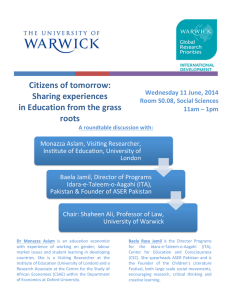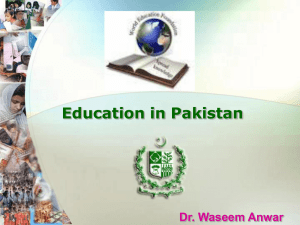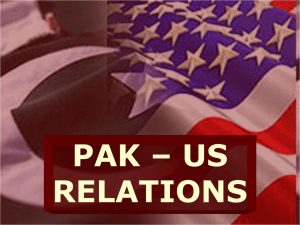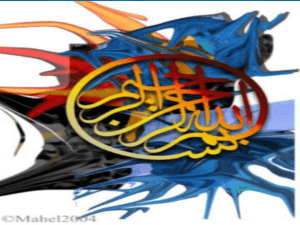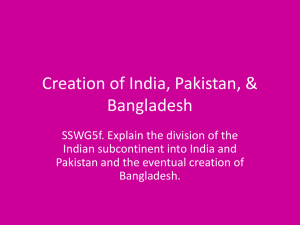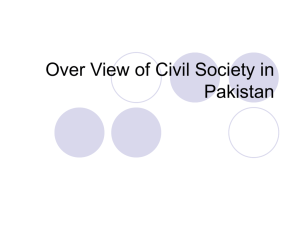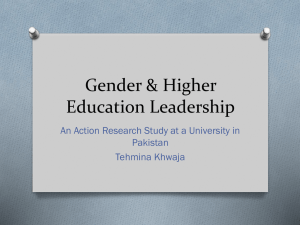Reducing Gender Gap in Muslim Societies - The Maria
advertisement
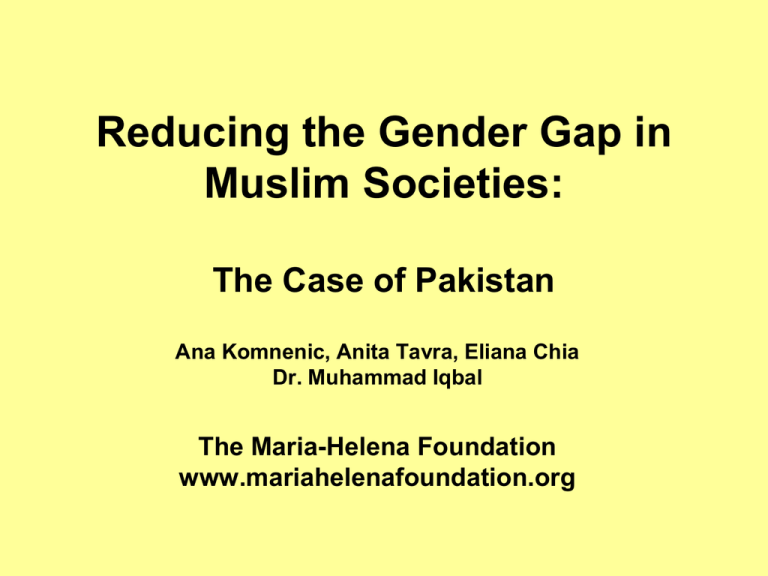
Reducing the Gender Gap in Muslim Societies: The Case of Pakistan Ana Komnenic, Anita Tavra, Eliana Chia Dr. Muhammad Iqbal The Maria-Helena Foundation www.mariahelenafoundation.org The Case of Pakistan The Benefits and Limitations of Education as a Development Tool Getting to know Pakistan THE ISLAMIC REPUBLIC OF PAKISTAN 95% OF POPULATION IS MUSLIM INDUS VALLEY CIVILIZATION, 5000 YEARS POPULATION OF 187 MILLION Life in a patriarchal society. Education in Pakistan In practice, no universal or compulsory primary public education system. Low attendance at primary and secondary schools. Government vs private education and the problem of corruption. Non-Formal Basic Education reaching girls. Lack of educational resources. Worldmapper: Primary education spending Country size is based on the proportion of all spending on primary education, measured in purchasing power parity. Between 1998-2008, Pakistan allocated 2% of the central government expenditure to education (UNICEF, 2011) The Situation for Girls • • • • World’s bottom 10 for female primary school enrollment. High drop out rates, especially in rural areas. Lowest literacy rates in South Asia Contrast between political environment and cultural attitudes. Why the Gender Gap in Education? • • • • Higher earnings for males The social organization of families. Children as a form of insurance. Protecting honour and modesty. Better returns for female education... Estimated economic returns for female education is higher than for males at all education levels. Importance of low level education. Monazza Aslam Reasons? Fertility Rate Child Mortality Maternal Mortality Underweight newborns Investment in Female Literacy has the Biggest Bang for The Buck 5 dollars invested in female education is worth 100 dollars invested in economy Moral of this story? Invest in female education Female Literacy Rate Connecting Female Literacy to Human Security 8 7 6 5 4 3 2 1 0 Comparing Female Literacy and Fertility Rates Empowering women through higher education What are the benefits of higher education for women? (1) Awareness of legal rights (2) Economic independence (3) Better civil society participation What are the limitations? Cultural norms as barriers to legal rights. Education biases. How the Maria-Helena Foundation is reducing the gender gap • MHF has 13 primary schools where more than 200 women are employed. • MHF has 2 vocational training schools in which several teachers are employed and are training women for the garment industry. • MHF has several scholarships for women only in middle and high schools. • As we believe women should have a voice at the decision making level, MHF has persuaded one of its conservative partner NGOs to have 3 women on its board. . One of the Maria Helena Foundation’s primary schools One of Maria Helena Foundation’s vocational schools References • Aslam, Monazza. “Rate of Return to Education by Gender in Pakistan.” 2007. Oxford: Global Poverty Research Group. • Bilquees, Faiz, and Najam Us Saqib. 2004. “Drop-Out Rates and Inter-School Movements: Evidence from Panel Data.” Islamabad: Pakistan Institute of Development Economics. • Malik, Samina, and Kathy Courtney. 2010. “Higher education and women’s empowerment in Pakistan.” Gender and Education 23(1): 29-45. • United Nations Children’s Fund. 2011. “Adolescence: An Age of Opportunity.” The State of the World’s Children, 2011. New York, NY: UNICEF. THE END

